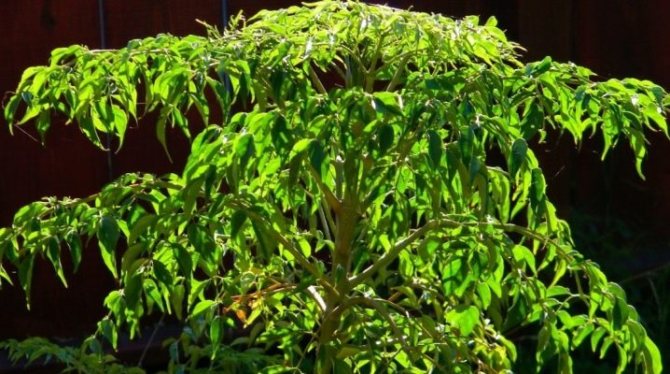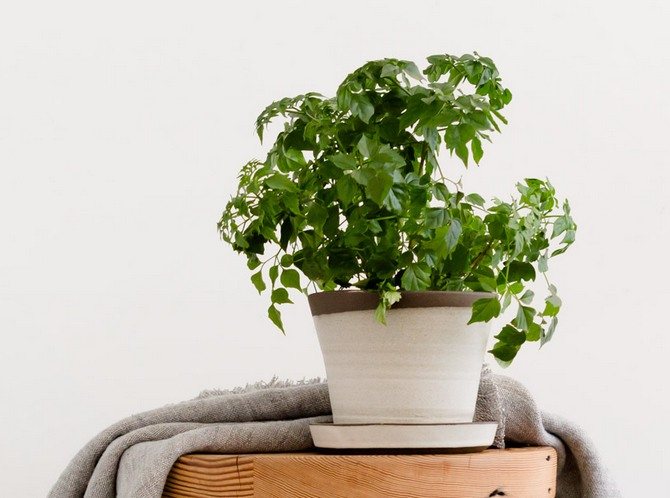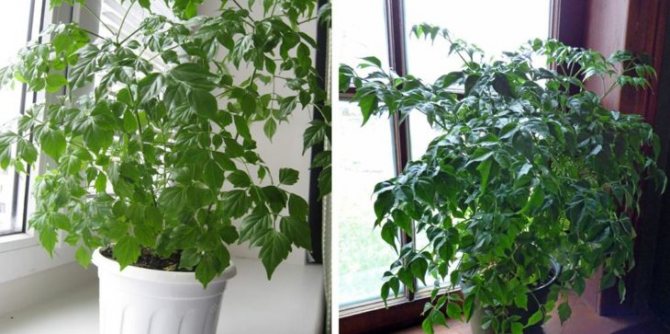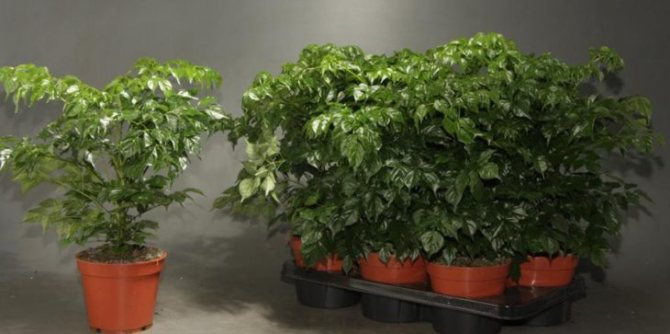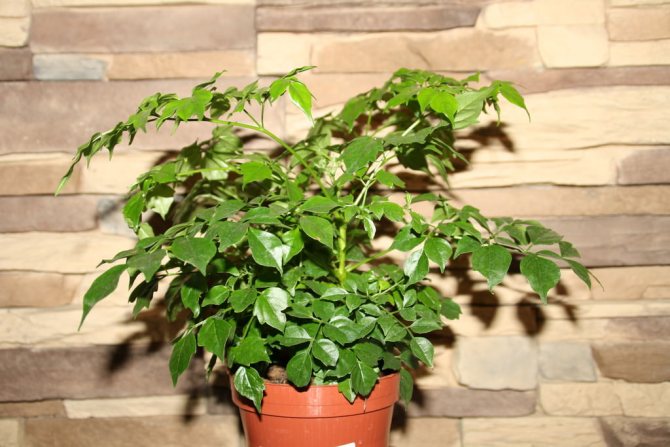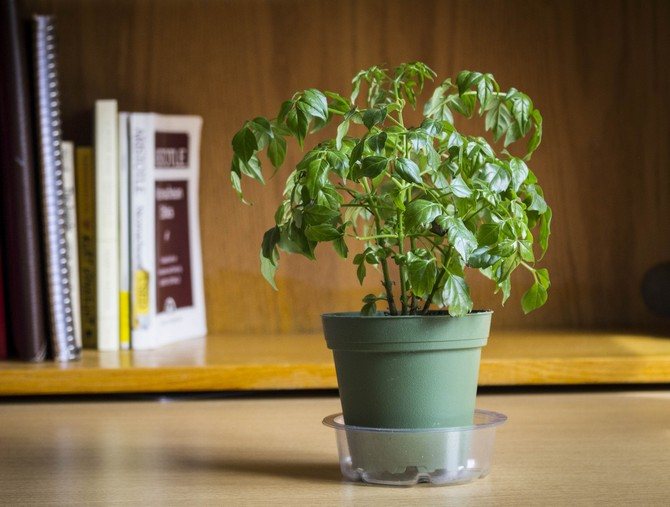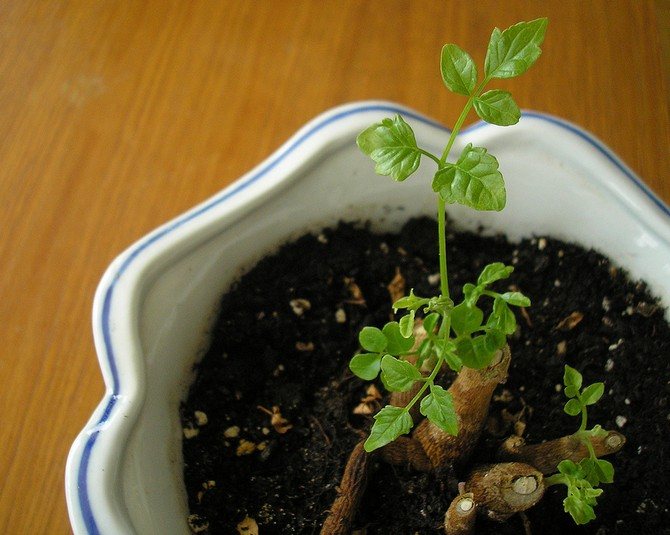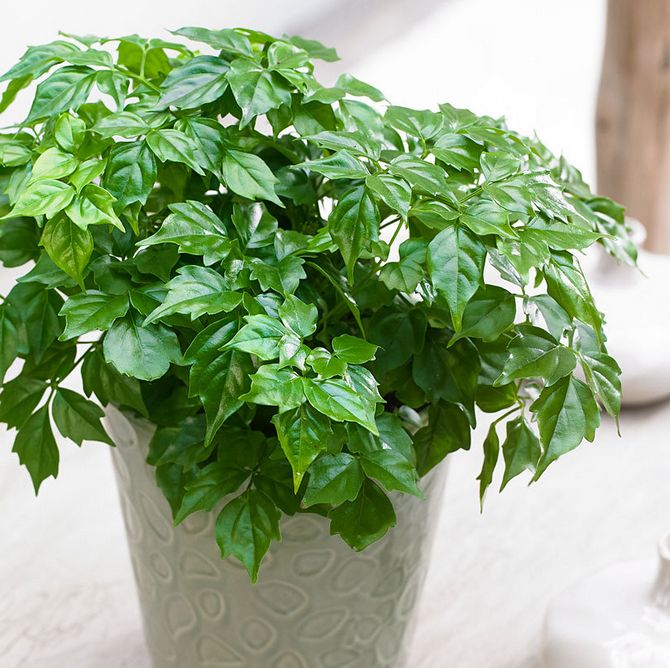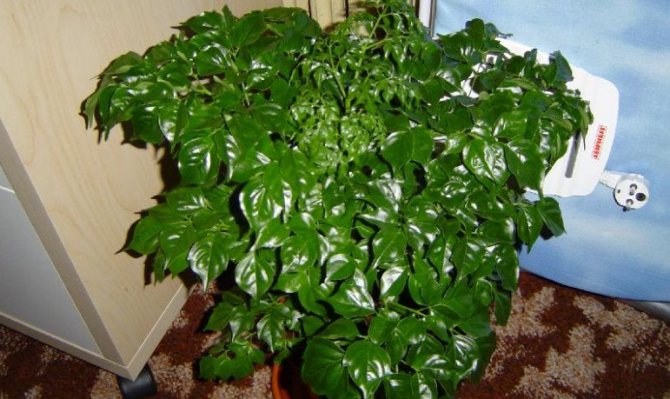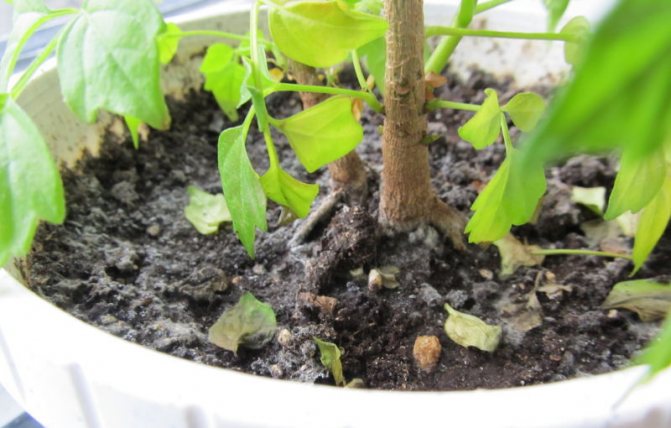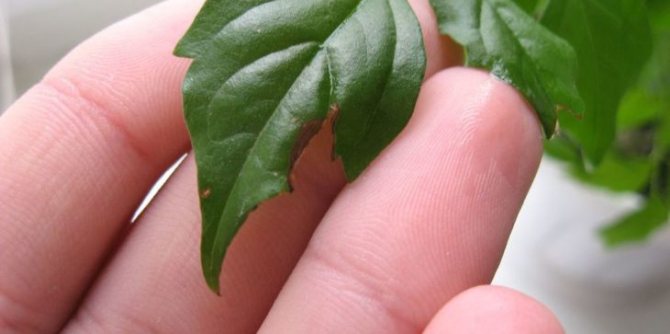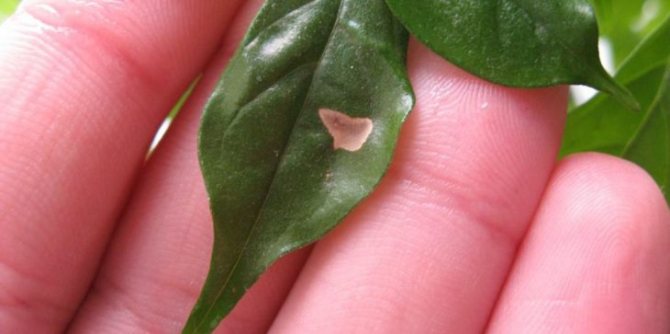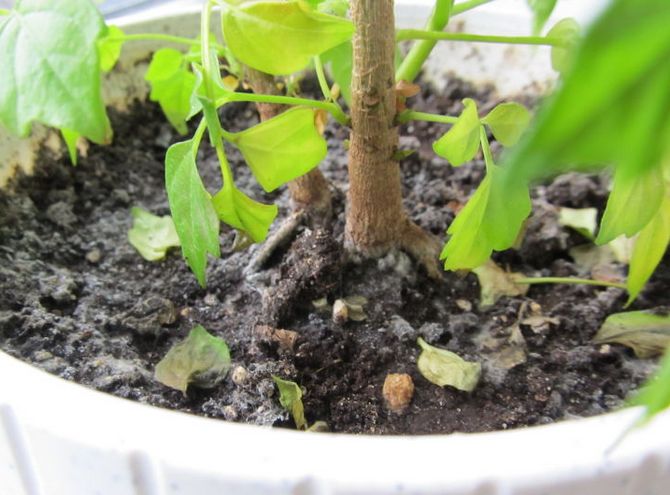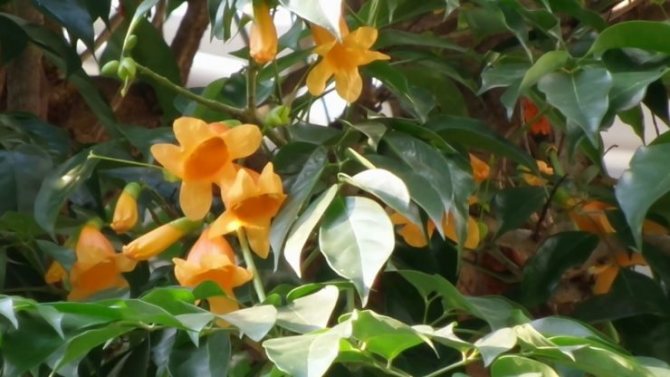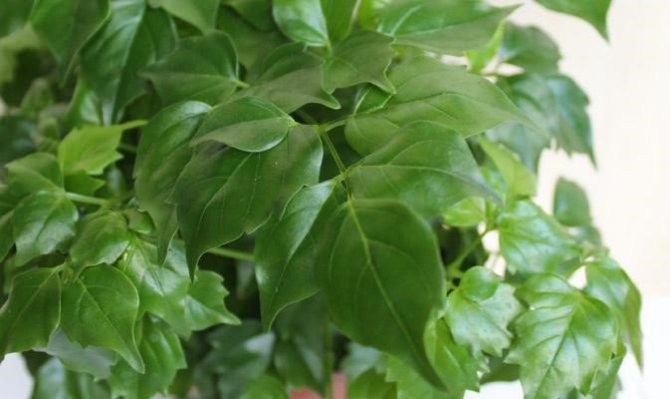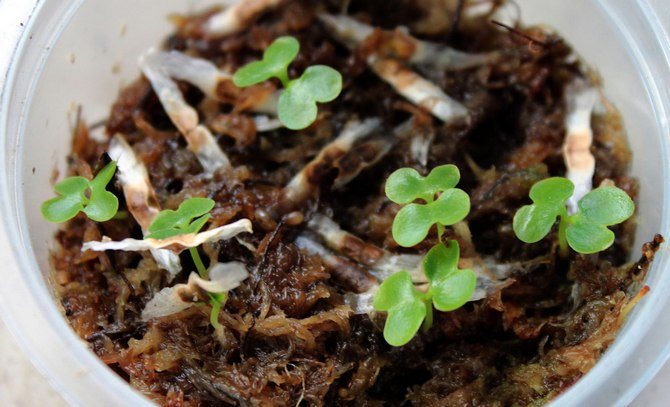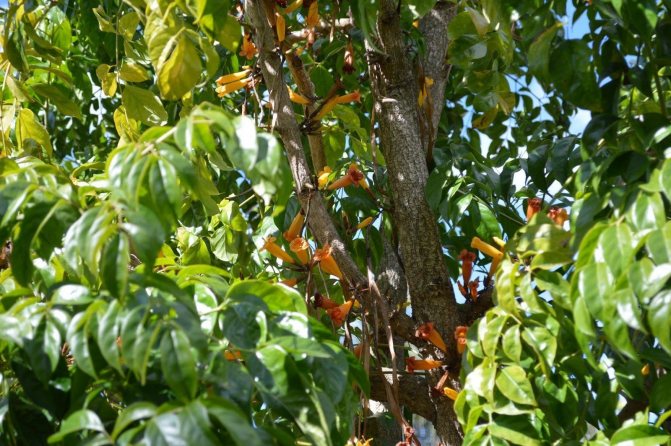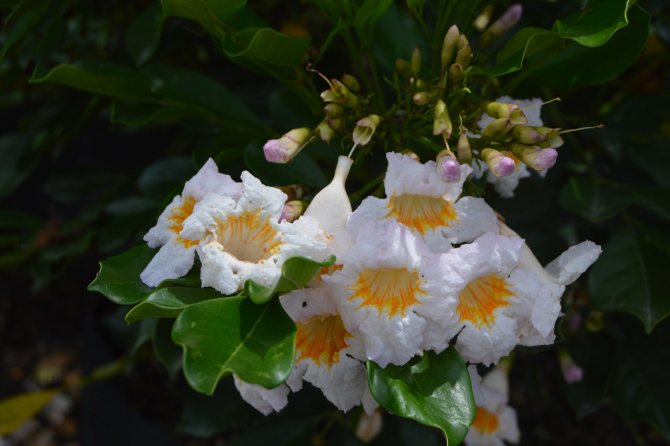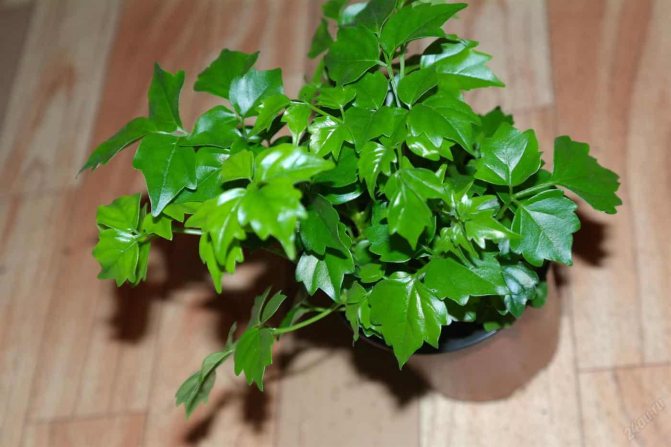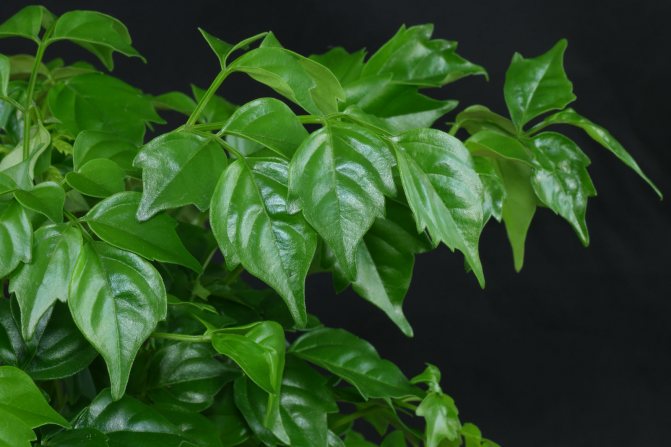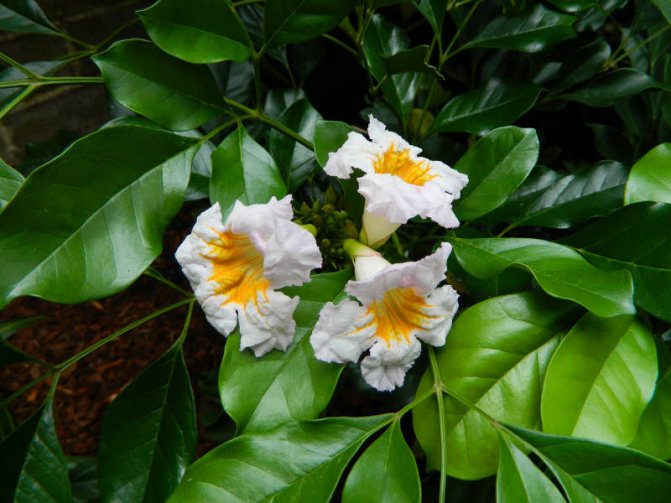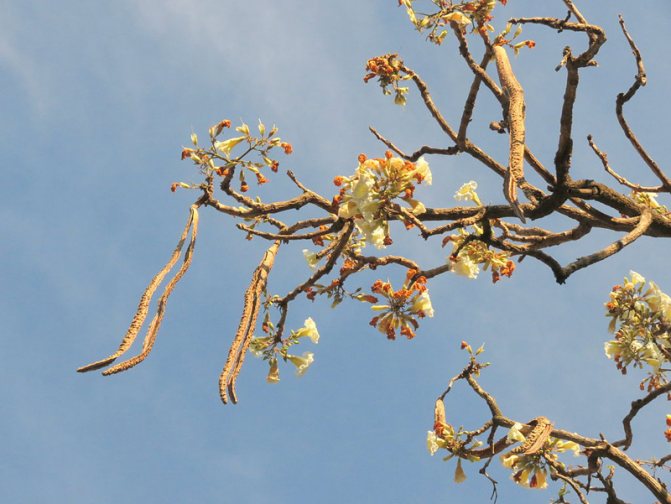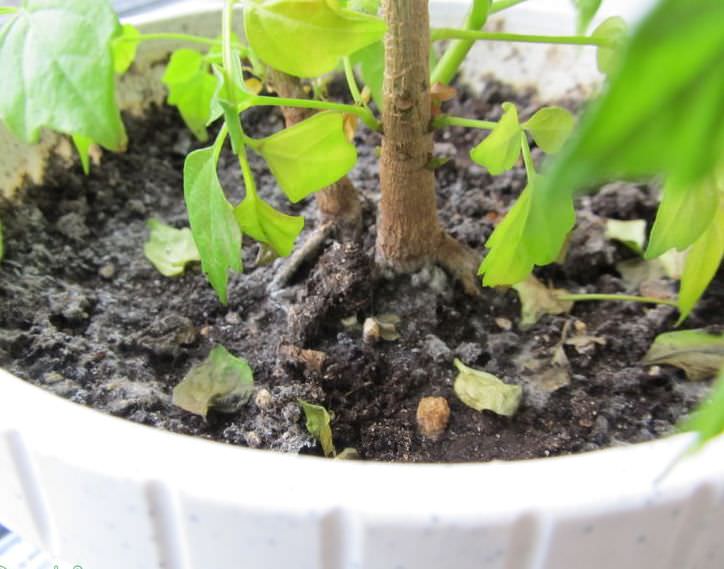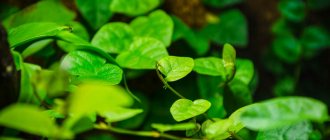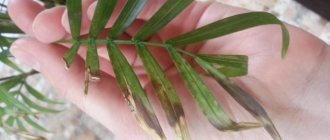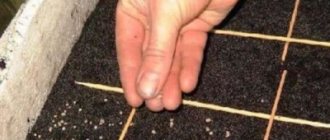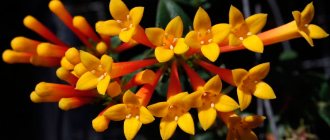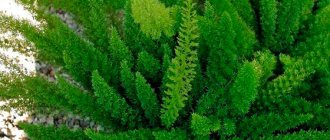Good afternoon, dear readers! What a miracle - a blooming radermacher! Flower petals can be cream, white or yellowish orange. Depending on the variety, they can smell like jasmine, cinnamon or cloves.
The peculiarity of emerald tree flowers is that they open only at night. Unfortunately, the first flowering of a house tree occurs only in the 15th year of its life.
Despite this, flower growers willingly grow this plant, since it does not require special care and looks very pretty. How to care for him year after year, so that one day buds will appear on the branches?
Caring for a radermacher: what to consider
If you know how to care for a radermacher, then growing it will be a real pleasure. The plant is completely unpretentious. But at the same time, it is very grateful and capable of growing at a gigantic pace, to the delight of the florist.
Florists' recommendations on how to care for a radermacher after purchase say that you can start with a transplant. But it is best to give the plant a couple of weeks to acclimate, and only then start changing the pot.
Unpretentious Asian is a big lover of light. But she prefers only diffused lighting and absolutely cannot stand direct sunlight. Exposure to the bright sun and lack of light are dangerous for the radermaker. Florists recommend creating the following conditions.
- Optimal location. An indoor flower will feel comfortable on the west window or on the east one.
- Arrangement of the place. You can place an emerald tree on the northern windowsill, provided that sunlight reaches it. If the choice has settled on the southern windowsill, then it is necessary to shade the window with a matte curtain or film.
- All-round light. The best place for a radermaker will be a glazed loggia or bay window, which provides lighting from all sides. In this case, the tree will grow proportionally.
- Constant turning. If it is not possible to ensure a uniform flow of light, then you need to remember to periodically turn the plant. Thus, all branches will be equally developed.
Temperature regime
Growing a radermaker at home does not require the creation of special conditions. The indoor tree readily adapts to natural temperature changes. It is not necessary to provide him with a decrease in temperature in winter, since the radermacher does not bloom. To create comfort for the plant, use these recommendations.
- In summer . Emerald wood loves warmth. It easily withstands up to + 28 ° C. The tree can tolerate even intense heat. But in such conditions it is imperative to increase the air humidity.
- In winter. The plant does not need cool conditions. But at the same time it can withstand a drop in temperature to + 11 ° C. Experienced florists advise to provide the radermaker with a winter rest. After hibernation, the tree grows more actively and is less sick.
An Asian guest loves moderately humid air. In conditions of sufficient humidity, it can withstand the heat and will put up with the neighborhood of heating devices. However, you should not overdo it with hydration. Otherwise, the radermaker will simply rot, starting from the root.Provide the plant with simple conditions.
- Normal humidity. Increase the moisture content of the air using different methods. You can resort to a pallet moistened with expanded clay, moss or peat, or just put containers with water.
- Spraying. Regular spraying of the crown with a spray bottle helps to combat low humidity.
- Bathing. Radermacher will gladly "take a shower", especially when the heating is on. But during the procedure, it is recommended to cover the soil with a film so as not to flood the root system. Bathing will help cleanse the plant of dust and dirt.
Radermacher needs abundant and regular watering. It is important to remember about a sense of proportion. Periodic watering or strong flooding "for later" is not suitable for the plant. The tree needs a regular supply of moisture in small amounts.
- Watering frequency. At normal temperatures, in spring and summer, the soil must be moistened three times a week. In this case, it is important not to allow it to dry out. If the temperature rises above 26 ° C, then the radermacher should be watered more often.
- Soft water. Only settled water is suitable for an emerald tree. You can apply rain. Chlorinated tap water is categorically contraindicated.
Radermacher grows very quickly. Therefore, it is necessary to constantly contain the excessive pace of development. For this, long shoots are periodically pruned. It is best to prune in the spring.
The top of a young radermacher must be pinched. This procedure will provide more branching to the plant.
Rapidly growing radermacher needs additional feeding. Fertilizers begin to be applied in March, when the active growing season begins. For the choice and application of dressings, it is recommended to adhere to these rules.
- Correct fertilization. The emerald tree is suitable for mineral fertilizers intended for decorative deciduous crops. If the radermacher has variegated foliage, then the nitrogen content in the top dressing should be minimal, otherwise the tree will lose its variegated "zest".
- The frequency of feeding. Fertilizers must be applied every 15-20 days. This is enough to ensure effective growth and full development.
- Application method. To properly feed the crop, it is necessary to dilute the fertilizer according to the instructions and add it to the soil after watering with plain water.
Read also: Kupena officinalis: medicinal properties and application
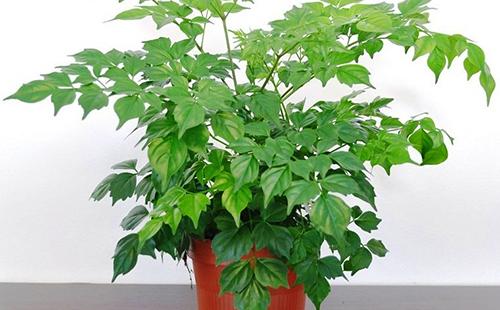
It is recommended to replant young plants annually. When the radermacher is three years old, this process will become much more complicated, because the tree will become large. Therefore, adult specimens are transplanted only when necessary, approximately once every two to three years.
The best time for transplanting is spring, the first days of March. Therefore, even a plant purchased in the fall is better to leave until spring. But if the root system grows through the drains, then after two weeks of acclimatization it is necessary to transplant the radermaker into another pot. The transplant is carried out according to the following rules.
- Pot selection. The new flowerpot should be only 2-3 cm larger than the old one. Radermacher has an underdeveloped fibrous system, so large flowerpots are completely unsuitable for her. If you plant a tree in a very roomy pot, then instead of building up the crown, the emerald tree will develop roots.
- Soil preparation. The plant needs a loose soil that will allow for proper air circulation and sufficient drainage of water. For transplanting, it is recommended to prepare the substrate by mixing one portion of sand, two portions of peat and turf soil, and four portions of leaf. You can take a ready-made soil: universal or a substrate for decorative deciduous crops.
- Drainage system. To ensure a normal outflow of water and prevent stagnation of moisture in the soil, a large drainage is poured onto the bottom, approximately 3 cm.
- Transplanting radermachers. The plant is carefully removed from the old flowerpot.To check the condition of the roots, gently loosen the soil with a wooden stick. Do not separate the old soil with your hands and do not soak the rhizome in water. The emerald tree will not stand such events. And the reviews confirm this. The transplant is carried out according to the transshipment principle, moving the roots with the old soil into a new flowerpot and sprinkling them with the prepared substrate.
Varieties
To date, scientists have described 17 types of radermachers, the most common are the following.
Radermachera Kunming
Rademacher Kunming (Radermachera Kunming) - is a small tree that blooms, reaching 40-60 cm in height. In nature, it grows only in Thailand, and in other places it is found exclusively in private collections.
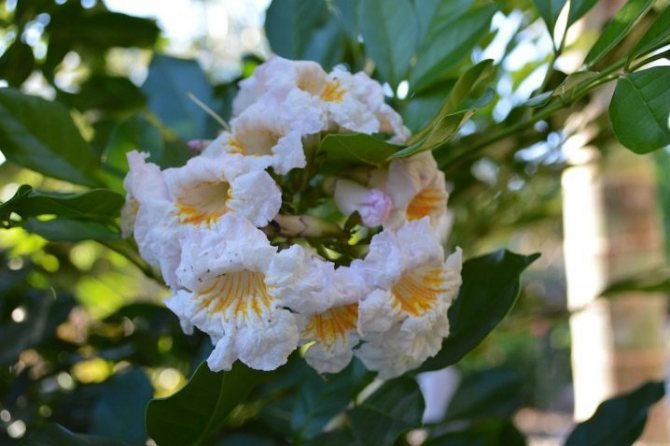

Radermachera ignea
Radermachera ignea - this species is better known as the "jasmine tree", it is widespread in the northern lands of Laos, Thailand, in addition, it is found on the islands of Hainan and Burma. The tree grows up to 20 m and has a rather unusual flowering - orange flowers form right on the stem.
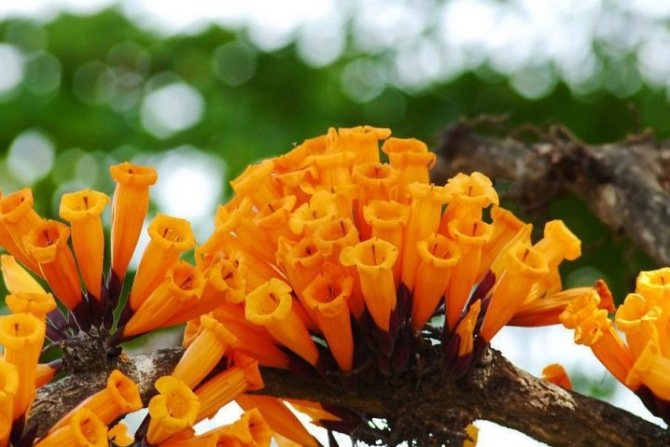

Radermachera ramiflora
Radermachera ramiflora - The range of this species is limited to the tropical forests of Borneo. A tall tree grows up to 25 and even 30 m, while the trunk is rather narrow - only 30 cm in diameter. The leaves are grayish, the flowers are yellow, they form rather large fruits - about 65 cm in length.
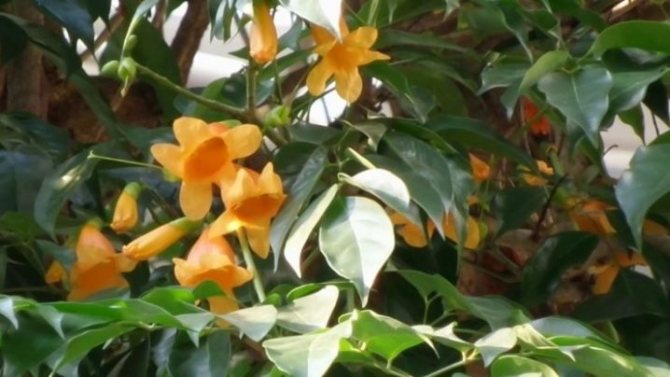

Radermachera xylocarpa
Radermachera xylocarpa - This species lives in India, the inflorescences here also grow directly on the stems and have a very decorative appearance.
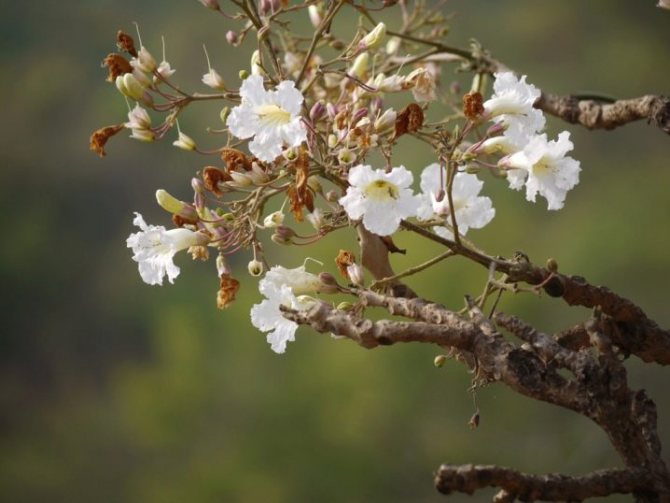

Despite the large variety of subspecies, only one is grown under indoor conditions - a Chinese radermacher or, as it is also called, a Chinese titmouse (Radermachera chinensis)... A characteristic feature of the flower are large shiny leaves, their length is close to 70 cm, and their width is up to 25 cm. The leaf plates are divided into separate segments of 4 cm each.
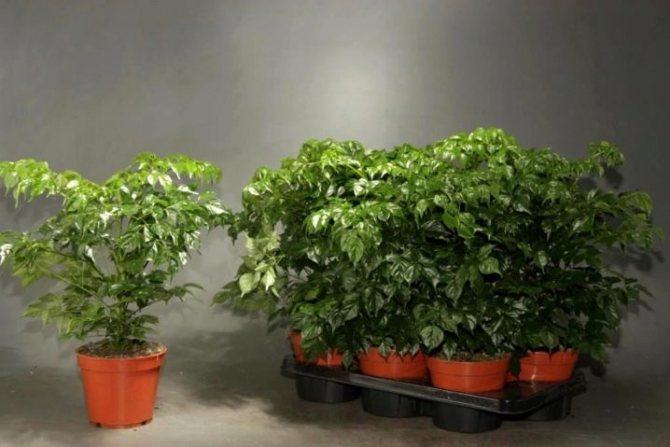

Growing problems
A non-capricious and strong plant can sometimes suffer from various diseases or pest infestations. In such situations, it is important to immediately determine what is the reason and take all measures to treat the radermaker.
Florist errors
Problems most often arise as a result of improper care or non-compliance with the "requirements" of the radermaker. Noticing the first signs of the disease on the table, immediately analyze what conditions you have provided for your green pet.
Table - Errors of care and methods of restoration of emerald wood
Transfer
During the first 5 years of a plant's life, it requires an annual transplant; subsequently, you can limit yourself to replacing the top layer of the soil every 2-3 years. A full transplant is carried out only if the grown radermacher has become very cramped in the pot. The root system of this plant is quite powerful and shaped, therefore the flowerpot should be deep and wide, but at the same time not too large - the volume of the pot should be comparable to the size of the roots.
If the pot is too small, then the growth of the tree will slow down; if the container is too large, moisture stagnation will begin in the layers of the earth that have not been reclaimed by the roots, which inevitably leads to the wilting of the flower. Despite the fact that this houseplant loves moisture, reliable drainage is important to it.
To do this, expanded clay or large pebbles or gravel are poured onto the bottom of the container in a layer of at least 5 cm. It is optimal that it make up about a quarter of the total volume of the flowerpot.
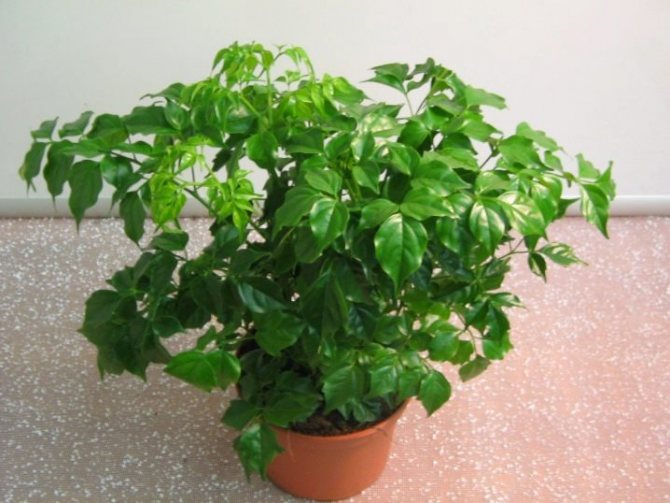

A pre-prepared substrate is laid on top of the drainage in a layer of 3-5 cm, be sure to keep in mind that the roots should not come into contact with hard stones. The sequence of actions for a transplant is as follows.
- The Radermacher is carefully removed from the old pot and, as far as possible, shaken off the ground.
- The roots are washed with warm water, removing all rotten areas, the rest are cut by about a third, and then sprinkled with crushed charcoal or activated carbon.
- The tree is placed in a new container, and the voids between the roots and walls of the container are filled with fresh substrate, lightly tamping it with your hands.
- After transplanting, the plant is watered and left for a couple of weeks in a shaded place - during this period there is no need to spray the plant and turn it, it is stressed, it is necessary to give the flower the necessary time to adapt to new conditions.
- Immediately after transplanting, wilting often begins, but after a short time after rooting, the flower is restored.
Radermacher - a striking evergreen flower, it has long been appreciated by amateur flower growers and is used as a wonderful addition to the interior in any home or office. The flower acquired such a strange name in honor of the Dutch scientist Jacob Radermacher.
He came to us from China in the eighties of the XX century. Its popularity does not diminish due to the fact that care of the radermacher uncomplicated is required. She is quite unpretentious.
Description and features of the radermacher
Radermacher is decorated with extraordinary leaves. This is probably why people called it the "emerald tree." In the wild, this tree can reach a height of 30 m. At home radermacher flower can grow up to 1.5-2 m.
The most important decoration of this flower is its beautifully shaped glossy leaves, pointed at the ends. There are so many of them that they create an amazingly beautiful and rich crown of a tree.
The color of the leaves changes depending on the type of flower. They come in a rich green color, and there are also beige tones, such as the Caprima variety.
In the wild radermacher chinese blooms with large white bells with orange tints. Moreover, the disclosure of these wonderful flowers occurs only at night. They smell insanely good, like cinnamon.
Bloom home carers rarely seen. The condition of the toothed leaves depends entirely on the quality of life and the conditions created by the flower.
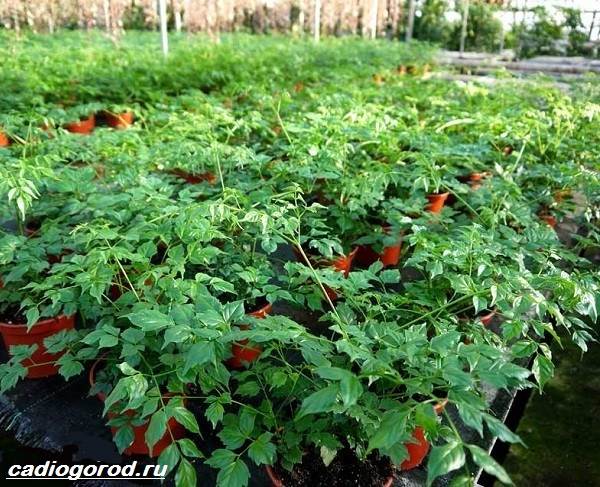

Radermacher in the photo Is something incredibly beautiful and fabulous. Her glossy sheets seem to be artificial, delicate work of a master. Sometimes it is difficult to believe that all this is created by nature. During flowering, all the beauty of the flower is doubled.
Planting and breeding radermachers
Reproduction radermacher mostly vegetative. In order for the root to take root well, it must be cut off in March-June. At least 10 cm of the shoot is cut off, transferred to a polyethylene container with a mixture of peat and sand and covered with foil. It is important to constantly water the soil, spray the future tree and try to maintain the temperature at least 20 degrees.
The flower also propagates with the help of layering. The stem of the flower is cut and wrapped in polyethylene with moss. In this case, the moss must be periodically moistened. After a while, the appearance of roots is noticeable.
The stem is then removed and placed in a separate pot. The flower will take on much better if it is not planted until there are many roots in the plastic bag. Planted such a stem grows much faster.
Radermacher
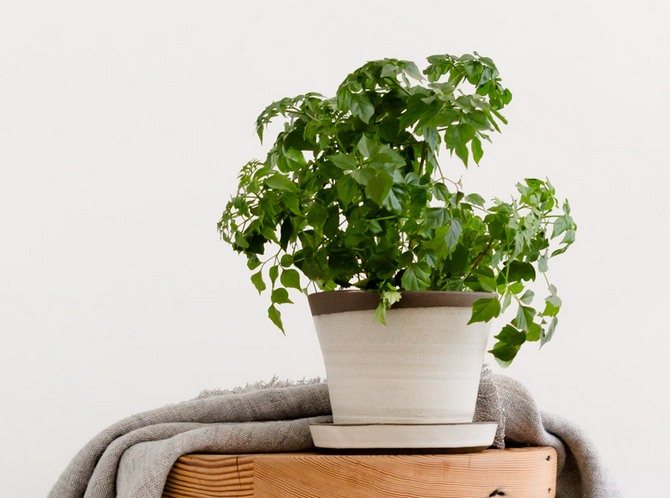

Radermachera (Radermachera) is an indoor evergreen tree that gained fame in Europe at the end of the last century, and has since become very popular among flower growers. It was brought from Asia, from the island of Taiwan, where it grew in natural conditions. The plant is named in honor of the botanist J. Radermacher, who first described it, who studied new types of flowers back in the 18th century.
Radermacher belongs to the Bignoniev family and is distinguished by decorative foliage, blooms extremely rarely at home. In nature, radermacher grows up to 30 m, with a trunk width of about 1 m. People call it the "Chinese doll" and "Snake tree", for the glossy foliage of a beautiful dark green hue - "Emerald tree".
Read also: Pineapple - full characteristics, medicinal properties and preparation of pineapple
Crown formation
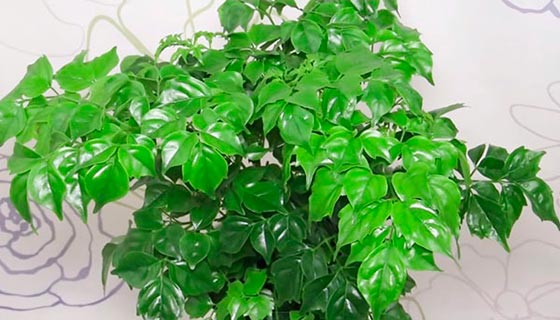

The emerald tree tolerates pruning well; you can form its crown by pinching the tops of the stems. From this, the bush becomes more luxuriant, and the leaves begin to shine more strongly. When to prune? Even in winter, the plant responds well to this procedure. But it is better to wait for spring, the time of active growth of branches. The glossy foliage is so beautiful that it doesn't matter if the plant is blooming or not.
Caring for a radermacher at home
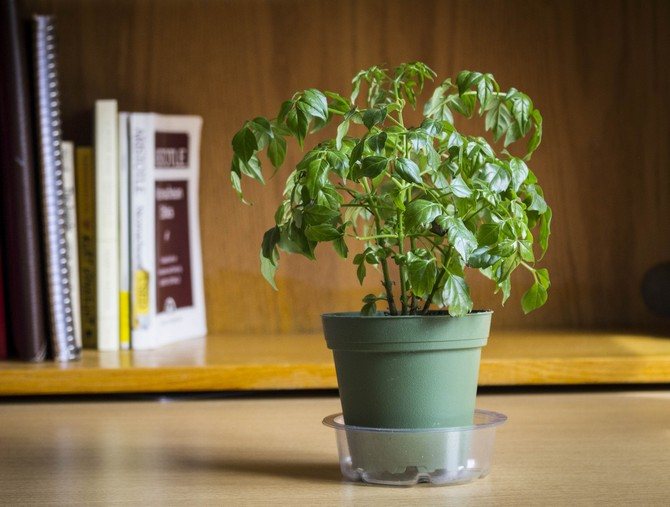

Location and lighting
For good development and growth, a Chinese tree needs a bright place, excluding too active sunlight. Western or eastern window sills are preferred. On the south side, it is necessary to create partial shade to avoid foliage burns, which can lead to the death of the plant. In the winter months, you need to ensure that the amount of light is sufficient, otherwise the radermaker may lose its decorative shape.
In addition, it is necessary to rotate it around the axis for uniform symmetrical growth. This is especially true for the first year of life. The lack of light can be compensated by using fluorescent lamps or phytolamps during daylight hours.
Temperature
The air temperature in the room with the radermacher should be at the level of 20-25 degrees, in the winter months at least 10-14 degrees. The plant prefers fresh air without drafts, so do not place a pot of Chinese wood near air conditioners, vents and balconies.
Air humidity
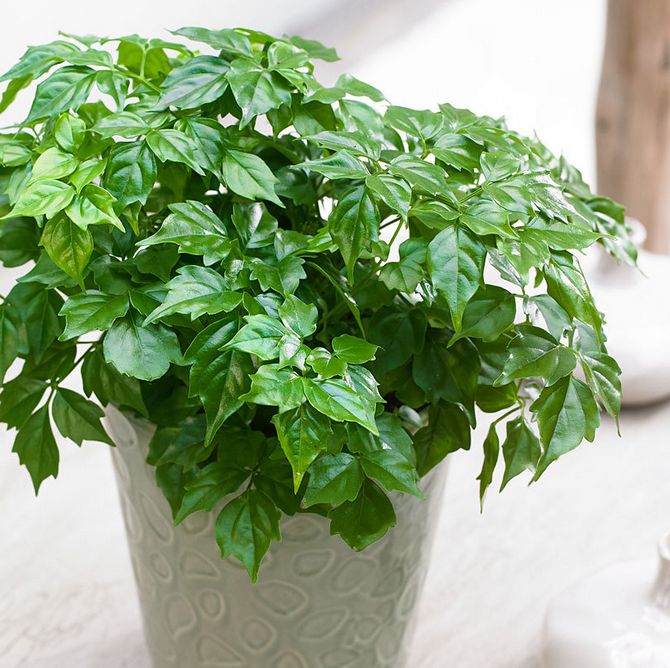

Air humidity for a radermacher is not important - it adapts well to dryness, although moderate humidity is still preferable for it. To maintain it, the plant is sprayed; in the summer, even bathing in the shower is possible. Palletizing damp expanded clay, moss or pebbles will also maintain optimum moisture.
The radermacher should be watered abundantly and regularly with settled water at room temperature. By winter, watering is gradually reduced, without overdrying, but not overmoistening the soil in the pot. The substrate should be slightly damp at all times.
Top dressing and fertilizers
Fertilizers are applied to the soil about once every 2 weeks, using complex fertilizers for decorative leafy flowers. It is advisable to apply fertilizing after watering, so as not to harm the roots.
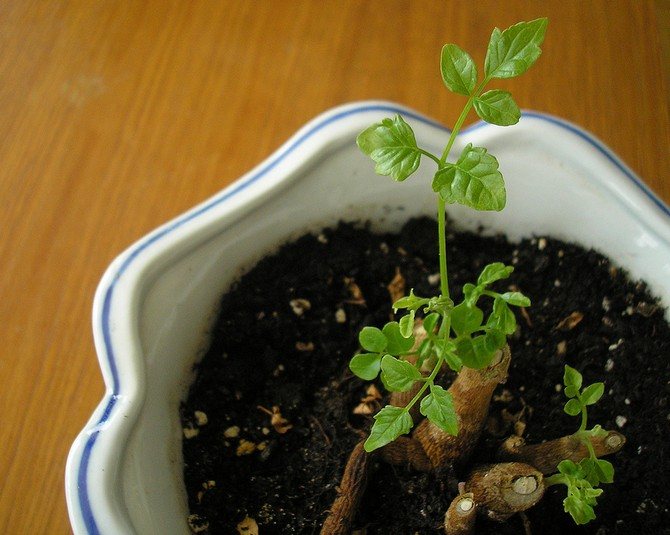

The soil for a radermacher should be fertile; a mixture of sod and leafy soil, peat and humus (1: 2: 1: 1) with the addition of sand is suitable. Or, you can use regular purchased land for ornamental plants and flowers.
They are transplanted to the radermacher in the spring, every year, or as needed, if there is not enough room for roots in the pot. This can be determined by the change in the color of the leaves and the general sluggish appearance of the plant. The new pot should be more voluminous, and always with a good drainage layer, about 3 cm.
Watering rules
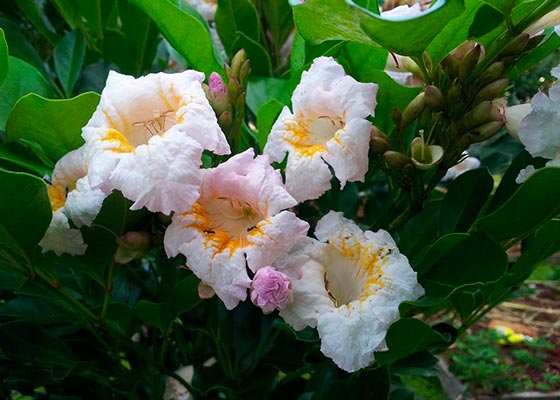

A well-moistened soil is required for the normal development of a radermacher. Water the plant frequently and abundantly. Don't wait until the topsoil is completely dry.
Also, do not allow water to accumulate around the plant's root system. Make sure to make a drainage layer in the pot. Water the Radermacher with clean water, previously settled.
Reproduction radermacher
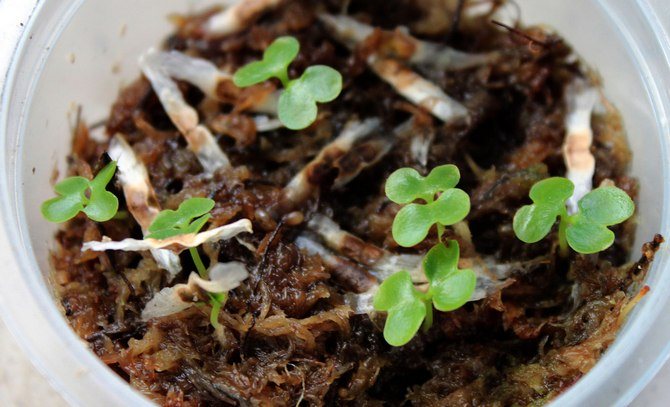

Reproduction of Radermacher Radermacher is possible by cuttings, layering and seeds. Cutting is carried out at the beginning of summer, cutting off the top of the shoots of about 10 cm, and placed in a container covered with plastic wrap with sand and peat. The temperature under the film is maintained in the range from 22 to 25 degrees, the plant is periodically sprayed and ventilated.
For reproduction by layering, the stem is cut and wrapped in cellophane and moss, which is moistened from time to time. Roots will appear soon, and then you can separate the stem for planting in a separate pot.In order for the plant to take up well, it is necessary to wait for the entire package to fill with the roots, then the new tree will grow faster.
Radermacher seeds germinate for about 10 days, sow them in a well-fertilized moist soil and cover with cellophane wrap. The seed method is rarely used, because it is quite difficult to grow them, and they are extremely rare on sale.
Radermacher Chinese (titmouse) in indoor breeding
Blue leaves do not exceed 90 cm long. The foliage is complex, consisting of numerous pointed oval-shaped leaves no more than 2.5 cm long. The leaves of a decorative indoor perennial are arranged horizontally, in several "tiers". The plant looks especially attractive when planted in one flower pot of three or four specimens at once, differing in the height of the aboveground part.
Quite often, the Chinese radermacher is used to create a kind of "live screen". To this end, it is necessary to fix the stems of the plant on a decorative lattice, which separates one zone in the room from another. In this case, it is best to use large adult specimens with good foliage and high stems. At the flowering stage, the stems of the plant are quite densely covered with numerous yellow tubular-funnel-shaped flowers, and after flowering, the titmouse forms inedible fruits. Reproduction of the Chinese radermacher is carried out in a vegetative way.
In optimal comfortable conditions and subject to growing technology, a decorative perennial can grow up to one and a half meters, but plants up to 60-80 cm in height look best. In taller specimens, decorativeness is significantly reduced, which is due to the exposure of the lower stem part. The culture grows quite actively, and in the absence of annual pinching, the growth is 25-30 cm or more.
Growing difficulties
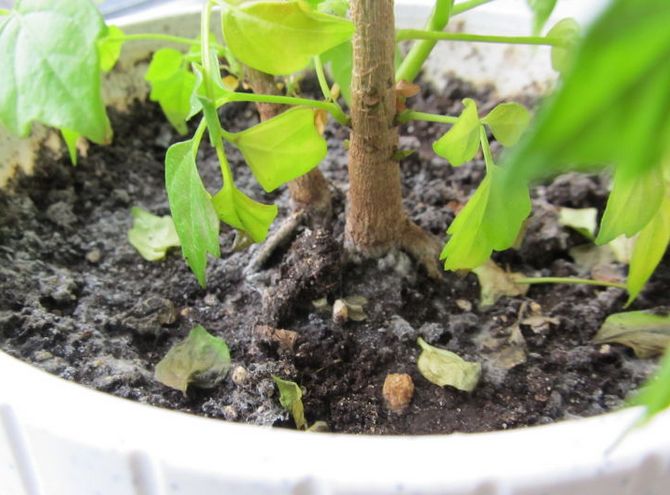

Arising problems with the plant arise mainly when the conditions of detention are violated:
- From excessive watering, the tops of the shoots begin to rot, the leaves turn yellow.
- Lack of lighting affects the shape and beauty of the radermacher - the leaves become small, the crown is elongated. It is even possible to shed the foliage, sometimes completely. It is urgent to rearrange the pot, and the tree will recover.
- Dryness and insufficient watering will affect the beauty of the leaves - they become lethargic and lifeless.
How to care?
Let us dwell in more detail on the features of caring for a radermacher.
Watering
In the period from March to October, the plant needs abundant watering as the soil dries up. In autumn, the number and volume of irrigation are gradually reduced, and in winter they are watered altogether a couple of days after the topsoil has dried. Drying out of the earthen coma can not be allowed in any way, the soil must constantly remain moistened.
At the same time, excessive moisture is detrimental to the plant, it leads to waterlogging of the soil, as a result, the roots die off, and the ground part does not receive the moisture and nutrients necessary for normal life, the flower begins to dry and dies rather quickly. Only soft water is suitable for irrigation, preferably pre-settled or filtered.
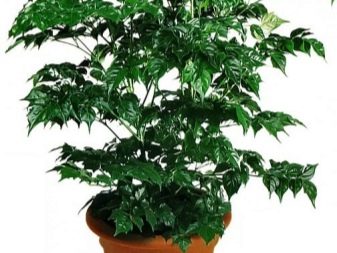

Top dressing
In the stage of active growth, the plant requires additional feeding; the radermaker responds best of all to balanced mineral preparations diluted in water at the rate of 1.5-2 g per 1 liter of water. Top dressing should be done every 10-14 days the next day after watering. In winter, while maintaining the temperature background at a level of at least 20 degrees, the plant does not need fertilizing, but if the room is cool, then fertilizer can be applied once a month.
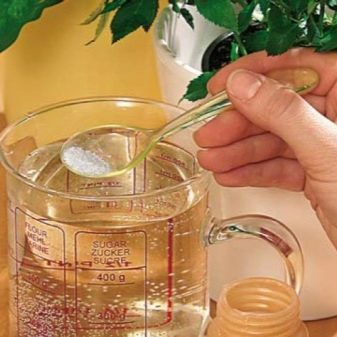

Pruning
An ornamental plant can be formed as a spectacular lush bush or a tree.In the first case, you will need to regularly pinch the apical buds of each shoot as they grow back, and in the second, you need to remove all lateral shoots distributed on the lower part of the trunk.
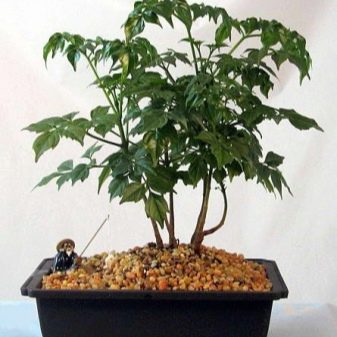

Radermacher care
Radermacher ("emerald tree") is an ornamental evergreen that, with proper care, grows into a powerful tree. Under natural conditions, the radermacher reaches truly gigantic sizes - up to 30 m with a trunk thickness of up to 1 m. The leaves are distinguished by an attractive glossy surface and a rich dark green color.
Read also: Chinese hibiscus: features of growing indoors
It is worth noting that it rarely blooms at home, but with proper care, you can grow a luxurious tree that will decorate any home.
So, in order for the radermaker to feel comfortable at home, she needs to provide the following care:
16 excellent varieties of plums for the Moscow region
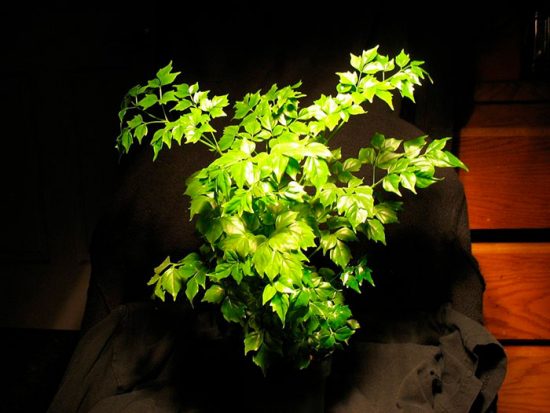

- Light mode. For a full and, most importantly, rapid development, a large amount of light is needed. This means that the place in which the container with the tree will be located must necessarily be very light, but at the same time without access to bright direct sunlight. The ideal option for the location of the radermacher is the west / east side of the room. If the plant will be on the south side, provide protection from the sun's rays. In the cold period of the year, make sure that the lighting was sufficient (phytolamps or fluorescent lamps will help with this).
Advice. In order for the plant to develop symmetrically, do not forget to periodically rotate the tree pot around the axis.
- Temperature conditions. The plant is very fond of fresh air, but at the same time it is afraid of drafts and low temperatures, therefore it is important to maintain the optimal temperature regime in the room where the radermaker "lives": in the spring-summer period the temperature should be at the level of + 20 + 25 degrees, in winter - not below 14 degrees Celsius.
- Watering and air humidity. Radermacher loves moisture, so it is necessary to water the crop with high quality and regularity, but at the same time, you should not flood the soil with water. In summer, the tree should receive more moisture, in winter the soil should be watered less often, but in no case should it overdry: the substrate should remain moist. As for the level of air humidity, the plant is not particularly picky about this indicator. Nevertheless, the radermacher will only be glad to have a “soul” from a spray bottle.
- Top dressing. It is necessary to sufficiently provide the culture with nutrients: ready-made mineral complexes for deciduous ornamental trees are perfect. They should be applied to the soil immediately after watering at intervals of 1 every 2 weeks.
- Disease and pest control. "Emerald tree" is not particularly susceptible to disease, and pests are not able to cause severe harm to it. Nevertheless, sometimes a spider mite may "visit". Any insecticide will help get rid of it. In addition, immediately after finding an insect, all parts of the plant affected by it should be removed.
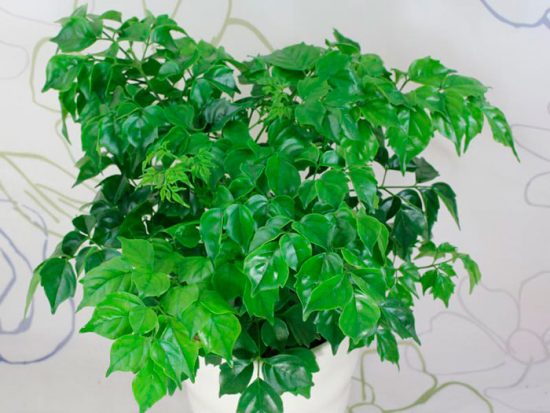

- Pruning. To form a symmetrical crown of a beautiful shape, you should periodically pinch the tops of the shoots. Radermacher, with the right actions, will quickly grow and become very lush.
- The transplant is carried out annually or as needed (when there is no longer enough space for the roots in the container) exclusively in the spring. A larger container is required. A good drainage layer is necessarily laid out on its bottom: its thickness should be at least 3 cm.
Features of the
A specialty of the radermacher is its decorative exotic foliage. In nature, the plant reaches a length of 30 m, while the width of the stem is about 1 m.The leaf blades are large - from 30 to 70 cm long and 15-20 cm wide, the color is green, some varieties are painted in rich, variegated colors. Flowers are bell-shaped, grayish-yellowish, each 5-7 cm in diameter. In the natural environment, these radermakers bloom only at night, exuding a persistent smell of cloves.
At home, only the Chinese radermacher is cultivated, it reaches a length of 1.5 m and is a compact bush with a straight trunk and drooping branches. The leaf plates are elongated, slightly pointed at the end and have denticles, rather large - up to 40 cm. The shade of the leaves is rich green, the surface is smooth and glossy.
At home, the plant practically does not bloom.
Reproduction methods
Radermacher can be propagated in one of three ways: by seed, cuttings and layering. The first method is rarely used in practice, since it is difficult to find seed on sale, and the process itself is not easy. Schematically, the process of sowing seeds is as follows: they are pre-soaked for a day, thoroughly dried and sown in containers with prepared nutritious moist soil. After that, the crops should be covered with a covering material. With proper care, the first shoots should appear in 10 days.
When propagating by layering, it is necessary to slightly cut the stem of an adult plant and wrap it with cellophane, then with moss. Periodically, the latter should be moistened. When the first roots appear, you can safely separate the stem from the mother plant and transplant it into an individual container.
And finally, grafting. This breeding method is usually used with the onset of summer. Cut off the tops of the shoots about 10 cm long and place them in a container filled with a mixture of peat and sand. Be sure to cover with plastic wrap. Ventilate the seedlings periodically and moisten the soil with a spray bottle. The temperature regime must be strictly observed (+ 22 + 25 degrees).
Conditions of detention
Radermacher is a tropical plant, therefore, for its successful growth and development at home, it needs to create a comfortable living environment.
Location
The Chinese tree prefers good lighting, but the light should be diffused, active sun rays cause burning of the leaves and a violation of the decorative color. It is optimal to place it in the east and west directions; additional darkening may be required on the south windows. To do this, they usually stick a reflective film on glass or use a light tulle. On the northern windowsills, the radermacher will lack light, then she will need additional artificial lighting.
Regardless of the location of the flower, it needs a daylight hours of 10-12 hours, therefore, in winter, it is worth taking care of buying a special phytolamp with a yellow glow spectrum, otherwise the plant will rather quickly lose its decorative effect, internodes will begin to stretch out, and the branches become like a liana.
In order for the radermaker to develop evenly, it must be periodically turned around its axis with different sides to the light, this is especially important for young plants in the first year of life.
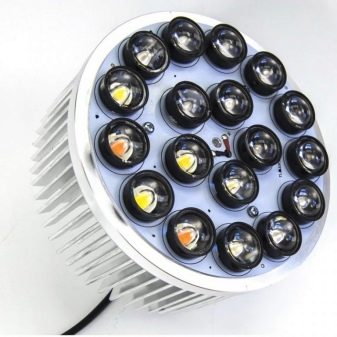

Priming
The land in which the flower grows should be loose, fertile, with high levels of water and air permeability. It is optimal to use ready-made soil mixtures, formulated for roses, palms and other decorative and flowering crops. If you wish, you can compose the substrate yourself, for this they take peat, humus and soddy-deciduous soil in a ratio of 1: 1: 2.
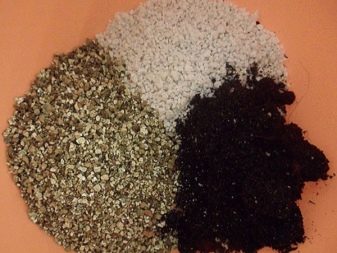

Temperature
A home native of the tropics prefers warm air, the temperature is considered to be 20-24 degrees throughout the year.The minimum allowable level is 12-14 degrees and only in winter, when the plant is in the dormant phase. If the air in the room is colder, the plant dies.
Elevated temperatures also have an adverse effect on the flower, but this can be mitigated by creating high humidity around your green pet. The plant responds very well to fresh air, however, it does not tolerate drafts, therefore, in the room where it resides, it is necessary to periodically air it, but so as to prevent blowing. Keep the flower away from fans, air conditioners, and balconies.
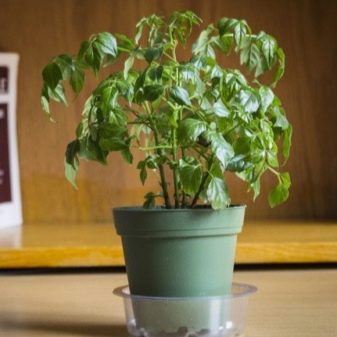

Humidity
For a radermaker, the indicator of air humidity does not really matter - this houseplant quickly adapts to dryness, although moderate air humidification is considered the most comfortable for it. To maintain optimal conditions for growth and development, you need to periodically spray the flower and arrange a warm shower for it. It will be useful to place an indoor fountain near a flowerpot; as an alternative, experienced flower growers recommend lining the pallet with moss.
Possible difficulties in growing
Sometimes, despite the full care of the plant, unpleasant external changes occur with it, the cause of which is difficult to identify. These changes usually include:
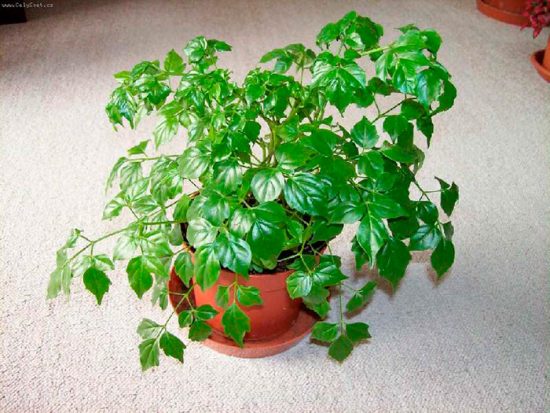

- Wilted leaves. Leaves can droop in two cases: when the plant does not receive precious moisture, or when it receives it in excess. In the first case, the amount of water applied to the soil should be increased. In the second, transplant the plant.
- Yellowing and falling leaves. Most often, such a nuisance occurs when the tree receives an insufficient amount of light. Correcting the situation is not difficult: put the pot with the radermacher in the right place.
- Shredding the leaves. If the plant is in a too dark place and does not receive an insufficient amount of nutrients, the leaves will definitely begin to shrink and fade. Solution to the problem: good lighting and a change in temperature.
- Pulling shoots. Provide adequate lighting and keep the flower in a cool place to prevent the shoots from pulling out.
That's all the nuances that should be taken into account when growing a radermaker at home. Good luck!
Flower bed design. TOP 10 simple and effective techniques
Why do the radermachers turn yellow and fall off the leaves
If the leaves on the plant fall off or turn yellow, then it is necessary to adjust the main measures for the care of an ornamental culture:
- insufficient lighting in the growing room;
- inadequacy of irrigation measures or excessive introduction of water into the soil lump during irrigation;
- depletion of the soil substrate or improper feeding.
Also, too dry air, drafts or improper temperature conditions can become the causes of foliage falling and yellowing.
Conditions depending on the season - table
| Season | Lighting | Temperature | Humidity |
| Spring | Radermacher categorically does not tolerate direct sunlight. Best of all, she feels on the north window in bright diffused light. Windows facing west or east will also work. If your windows face south, then the plant should be protected from the sun by a curtain. To form a uniform crown, the pot with the radermacher needs to be turned from time to time towards the light in different directions. An adult plant has a spreading crown, so it is best to keep it on a stand near the window so that the leaves do not touch the glass. | Radermacher is a thermophilic plant. In the spring-summer period, the plant will be comfortable at 20-25 ° C. With an increase in temperature, a little more moisture in the form of watering and spraying will help the flower to cope. | With regard to this indicator, the radermacher is not at all capricious.She will feel great with an overall humidity level of 50%. The plant does not need daily spraying, it tolerates dry air normally. You can only occasionally spray the foliage from a spray bottle with water at room temperature and wash off the deposited dust under the shower. |
| Summer | |||
| Fall | In winter, the plant will not be damaged by a slight backlight. Or, if possible, move the flower to a lighter window. With limited lighting, the shoots of the radermachers will begin to stretch, and with a critical lack of light, the plant is completely capable of losing foliage. | The autumn-winter period will pass without problems at a temperature of 18 ° C, a decrease to 13 ° C can cause a suspension of growth and partial loss of leaves. Temperatures below 10 ° C will be fatal for the radermacher. | |
| Winter |
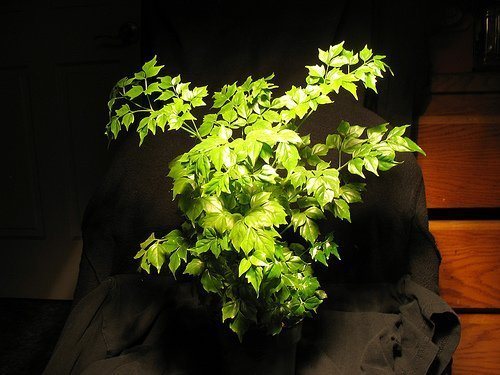

In winter, additional illumination will not interfere with the radermacher.
Table: pest control
| Symptoms | Pest | Measures of influence |
| Yellowing of leaves and deformation of shoots | aphid |
|
| The appearance of a fluffy coating on the leaves | mealybug | |
| Small cobwebs at the base of leaves or near roots | spider mite | |
| Yellowing and dying off of shoots, the appearance of brown sticky spots on the leaves | scabbard |
Photo gallery: pests radermachers
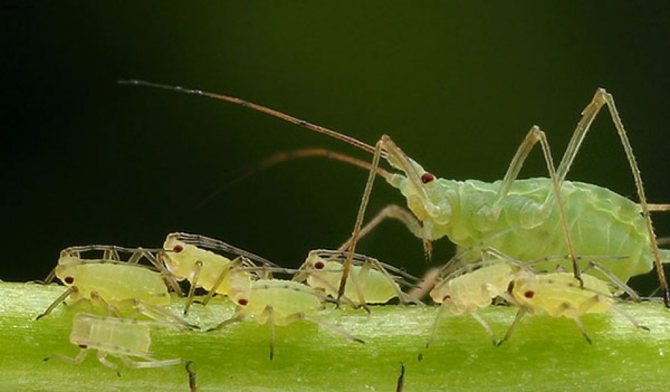

When damaged by aphids, the leaves of the radermacher turn yellow and the shoots are deformed.
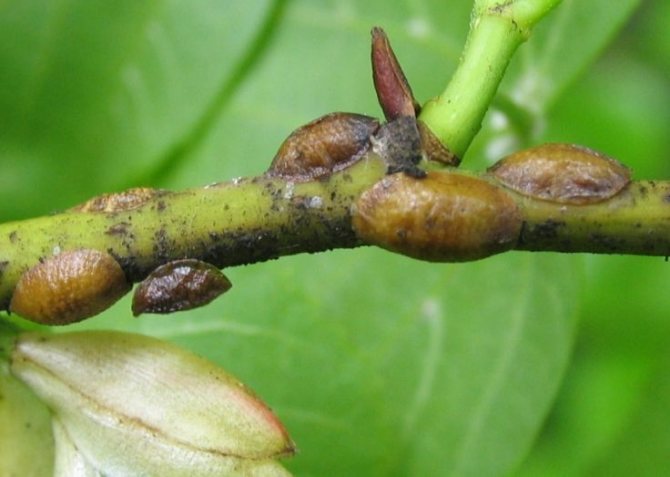

As a result of the activity of the scale insect, the shoots of the radermachers die off.
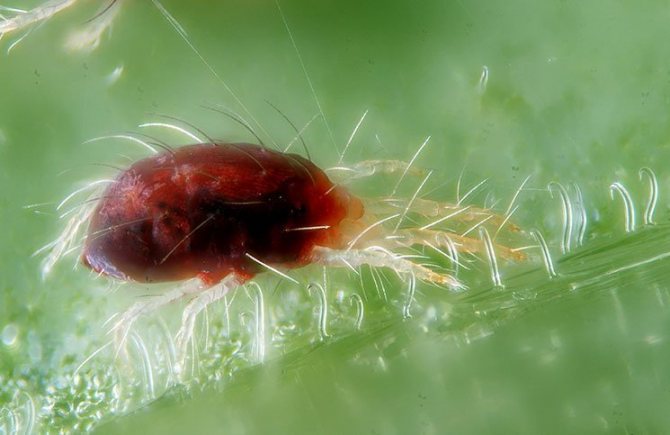

The presence of a spider mite is indicated by a small cobweb at the base of the leaves.
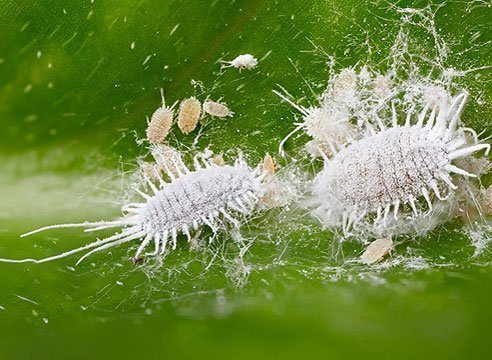

A sign of the appearance of a mealybug is small whitish balls on the leaves.
Care errors and their elimination
Common problems when growing Radermachers and their elimination:
| Problem | The reasons | Decision |
| Leaves are shrinking, shoots are stretched | Lack of lighting | Move the flowerpot to a brighter place, but without direct sun |
| Lethargy and drooping leaves | Waterlogging of the soil | Avoid stagnant moisture, water the plant only after the soil has dried a few centimeters deep |
| Drying of the tips of leaves and shoots | Moisture deficiency, too bright lighting | Increase the frequency of watering, at the same time you can increase the humidity of the air, provide diffused light |
| Shedding leaves | Lack of light | Move the flowerpot to a brighter place or provide artificial lighting |
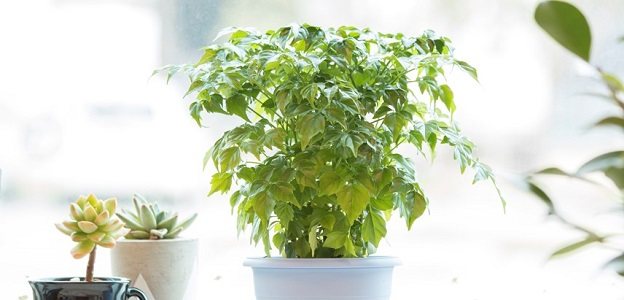

Diseases and pests
With the wrong care of the plant, the radermaker begins to wither and shed the leaves. Most often, flower growers are faced with the following problems.
- Leaves turn black, dry and fall off - this indicates decay of the roots. In this case, only a quick transplant can save the flower, all damaged areas of the roots should be removed, and the cut sites should be treated with Fitosporin or powdered activated carbon. After transplantation, the leaves should be sprayed with a solution of copper sulfate. This treatment should be repeated 2-3 times with an interval of 10-14 days, in the future it is necessary to bring the irrigation regime in accordance with the needs of the plant.
- Leaves become small and elongated - this indicates a lack of light, if you do not move the flower in a timely manner or organize the backlight, it begins to shed its leaves and wither.
- Leaf plates lose their elasticity - most likely, the flower lacks moisture.
Radermacher is distinguished by disease resistance, but she often becomes the subject of attack by such dangerous pests as aphids, mealybugs and spider mites. The drug "Actellik" demonstrates high efficiency in the fight against them, the treatment should be carried out twice at intervals of a week.
Before spraying, you need to physically remove parasites - for this, use a sponge and a concentrated solution of laundry soap.
For information on what types of radermacher exist, see the next video.
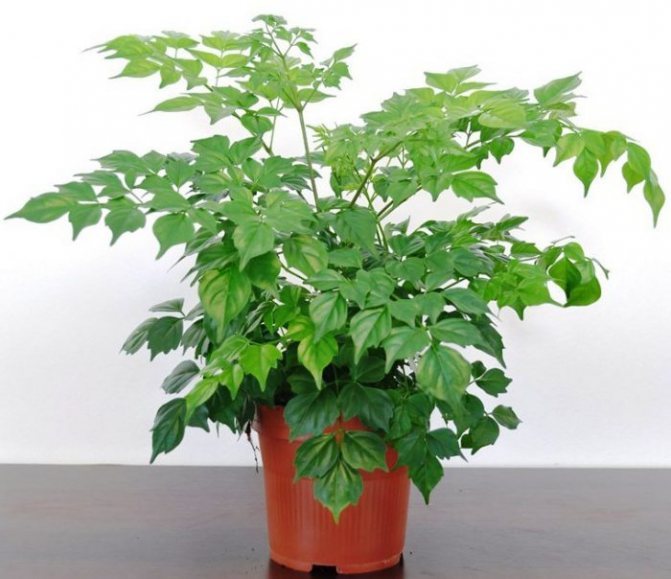

A kind of plants like radermacher (Radermachera) is directly related to the bignoniaceae family. The genus is represented by evergreen shrubs and trees. In nature, they can be found in Southeast Asia.
Main types
Radermachera Chinese (Radermachera chinensis)
It is a relatively compact evergreen shrub that can reach a height of 150 centimeters. The erect trunk branches strongly almost from the root. Large leaves are double or triple pinnately complex. Their length is approximately 40 centimeters. The glossy leaves of a rich green color are jagged along the edge. They have a lanceolate-elongated shape. When grown in an apartment, flowering almost never occurs.
Origin and description of appearance
In Europe, the radermacher first appeared only in 1980, although the Dutch botanist Radermacher described the genus as early as the 18th century. In honor of the scientist, the plant got its name.
The plant represents the Bignonium family, a genus of evergreen ornamental deciduous shrubs and trees.
Radermakhera is widespread in Southeast Asia and in the mountainous regions of China, where a subtropical climate prevails. Grows in open sunny glades and mountain slopes. Under natural conditions, it can reach 20-30 m, and at home - the maximum height of 1.5 m.
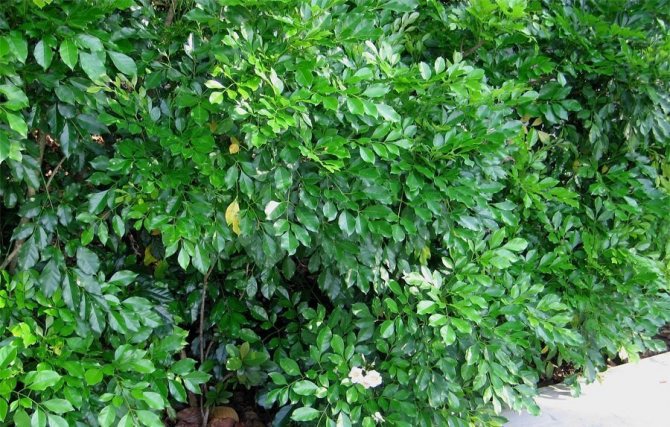

In the homeland of the radermacher, it is grown as a street plant.
The radermacher has sprawling, not too branching shoots. The leaf is complex, large, up to 30 cm long. It is located on a long petiole. Consists of opposite, triple plumose leaves, elongated-ovate. The leaf blade is slightly wavy, at the end it has a sharpness. These stunning emerald green glossy leaves are the main adornment of the radermacher. They create an openwork and lush, translucent crown, for which the plant fell in love with many flower growers.
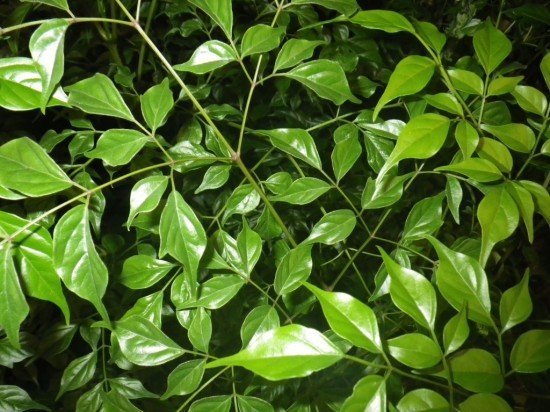

In an apartment, the plant does not bloom, although there are happy exceptions.
The radermacher blooms only in natural conditions. The flowers look like large bells of white, grayish-yellow or yellow-orange color. They bloom only at night and exude a delicate scent of cloves.
Blooming radermakers - photo gallery
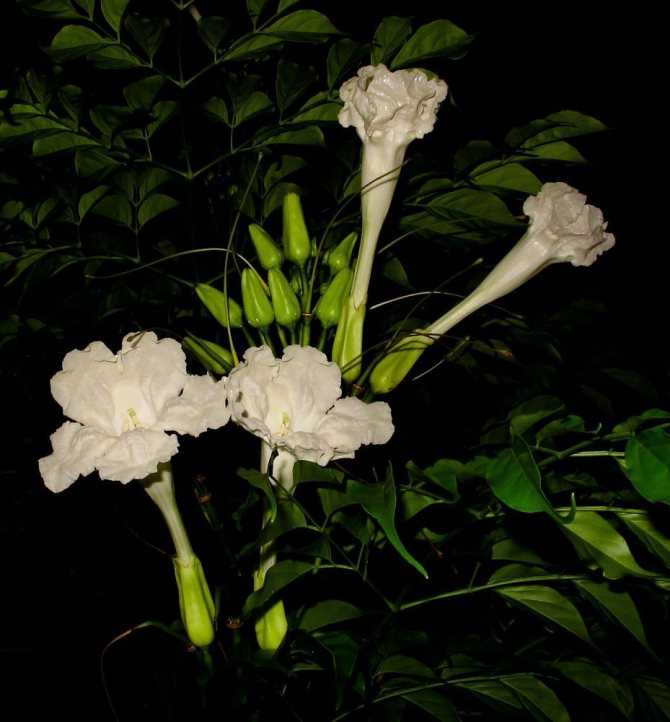

This is how the Chinese radermacher (or titmouse) blooms
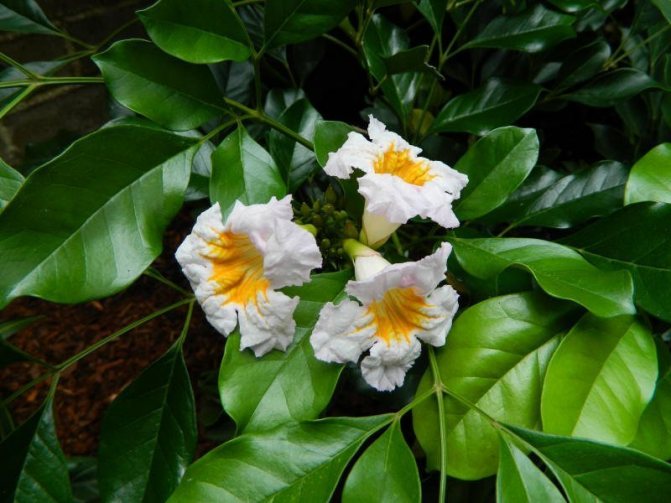

Lovely flowers radermachers cuming
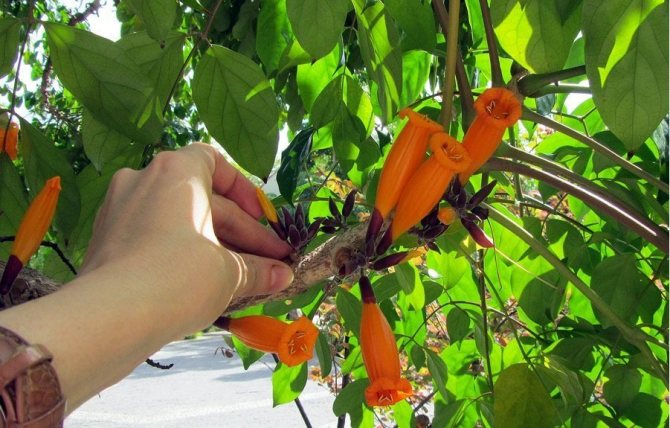

Radermacher fiery blooms with orange bells
The beauty of the radermacher belongs to picky plants, she perfectly adapts to the conditions of the apartment. Choosing the right place for growing and observing the minimum care requirements is within the power of even a beginner. The only problem can be the size of the plant itself, which grows very quickly.
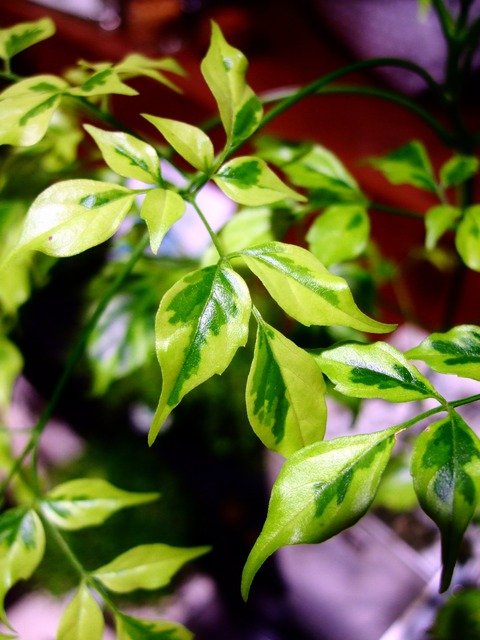

Radermacher Caprim belongs to variegated species
In nature, there are about 15 plant species. Among them there are variegated forms, for example, Caprim radermacher. But in home floriculture, only one is successfully grown - the Sinica (or Chinese) radermacher.
Trim / Support / Garter
In order for the tree to have a decorative look, it must be pruned every year. This procedure is carried out in the spring in mid-April. At this time, the longest branches are cut by 1/3. All thin and elongated shoots during the winter must be removed.
So that the tree grows more side branches and is lush, pinch the tops of its shoots... This can be done not only in spring, but at any time of the year. If the branch of the crown does not have lateral shoots, it must be pinched.
Fertilizer
Plant feeding is carried out only in the spring and summer. From the beginning of April to the end of August, the procedure is carried out twice a month. Since September, fertilization of the soil is gradually stopped.
As a top dressing, ordinary liquid complex fertilizers are used. Before use, they are diluted with water to obtain the concentration indicated on the package. Apply only to wet soil, i.e. a few hours after watering.
Organic fertilizers are usually not used for this species.
Folk omens and superstitions
Many popular superstitions are associated with this plant. For example, according to the teachings of Feng Shui, it can have a beneficial effect on the home and help fight sadness and boredom. For people who seek to know themselves and are engaged in spiritual practice, the emerald tree will help open the spiritual chakras and other channels that connect the soul and the upper world. However, even in favorable conditions, this plant can die, people say that it has removed damage or the evil eye from its owner, and also saved it from a serious illness.
You will be interested to know if you can keep a monstera flower at home.
Radermacher is not only a beautiful and unpretentious plant, but also an excellent addition to your harmonious life. It can make your home more comfortable and clean, as well as strengthen family ties, because according to folk signs, it helps family members to tune in to each other. The tropical origin did not interfere with the cultivation of the radermacher as a home flower. With proper care and living conditions, this plant can delight you with its beauty for long years.


